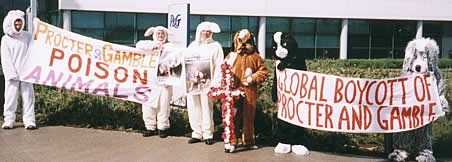|
Rabbit's Foot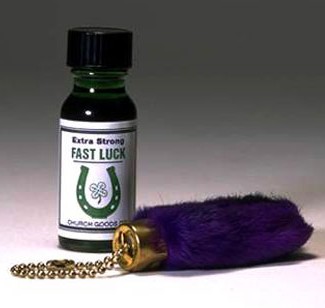 Like human sacrifice and faith healing, the lucky rabbit's foot is an ancient tradition whose best days may have passed.
Like human sacrifice and faith healing, the lucky rabbit's foot is an ancient tradition whose best days may have passed. Rabbits are native to Europe and Africa, where they're plentiful and tasty. Their fur was used to make clothing and boots; the remainder of the rabbit was good for meat. Over thousands of years, millions of families have eaten trillions of rabbits. Each of these bunnies came equipped with four paws. The paws aren't especially meaty, but they do preserve well. Although you can treat them for better durability, rabbit's feet don't really require any elaborate taxidermy. You pretty much dry it out and cover the stump (if you want it to be pretty).
So what do you do with the damn things? Well-bred ladies used to apply powder to their faces with rabbit's foot puffs. And medieval goldsmiths used rabbits' feet for polishing finished gold and silver products (which is probably how they came to be associated Similar practices were found in Asia (where rabbits were less prolific) and among native North Americans. In Africa, there was a well-developed tradition of using animal parts in witchcraft. Rabbits were considered fertility totems, due to their being such randy little bastards. When America began kidnapping Africans as slaves, they brought their religions with them, although they mutated into new forms in the New World. Among American blacks, practices like voodoo and Santeria made ample use of animal parts. In the U.S., rabbit's feet were employed for good luck by both the high and the low. While postage-stamp sized ads in early comic books and pulp magazines hawked their amazing lucky properties, gold-plated ornaments made their way to the rich and powerful. In 1909, President Teddy Roosevelt was given a gold-mounted rabbit's foot by Irish prizefighter John L. Sullivan. Roosevelt credited the foot with contributing to the success of his big-game hunting during the trip.
Many early blues men were heavily influenced by religion, whether it was occultish folk tradition or deeply felt Christianity. When the blues exploded into mainstream American culture in the 1920s, hoodoo became a force to be reckoned with. Hoodoo quickly became a cottage industry, as gullible white people flocked to buy lucky mojo bags, mojo spell books, mojo tinctures and mojo talismans. One of the best-selling mojo products was the rabbit's foot. By this time, large-scale rabbit farms in the U.S. and the U.K. were breeding millions of bunnies every year for meat. Penned in tiny cages and left to do what rabbits do best, these increasingly industrialized farms provided meat for human food and pet food, while other breeds of rabbit were cultivated specifically for fur. All of these rabbits had feet. While fur breeders occasionally used the feet as a tassle, the meat industry had no use for them. Fortunately, the Industrial Revolution had also fueled a booming American industry sector in novelty toys -- inexpensive, mass-produced trinkets marketed primarily to kids.
Hoodoo houses sold your basic two- to four-inch basic rear paw, basically unretouched. For the kiddies, the smaller, fuzzier front paws were often used, and the fur was dyed bright, unnatural colors, in order to distract parents from the fact that their children were carrying amputated animal parts around in their pockets. There are no reliable figures about how many rabbit's feet have been sold in the U.S. since mass marketing began in the 1940s, but it's safe to say the number is at least in the hundreds of millions. For decades, these trinkets were considered harmless fun for the kiddies. Then, starting in the 1960s, a militant sort of social consciousness arose on the topic of fur. For a while, the anti-fur movement was strictly a liberal hippie pursuit. Rabbit farming struck people as a particularly inhumane practice, with bunnies living out their lives in miserable overcrowding, where they became malnourished and mentally disturbed, chewing off each others' ears and then ignominiously slaughtered, bled dry, skinned and dismembered. Animal rights groups zeroed in on the rabbit farms, and on the commoditization of rabbit's feet as a symbol of all that was evil in this world.
Fortunately, there are still options for the discerning seeker of luck. The best option is to visit a taxidermist, where you can specify your requirements in some detail. When ordering, remember that the rear paw is the lucky one. Of course, the final product may not be extremely appealing as a key chain, but then, you're in this for the luck, right? You can also order more attractive real rabbit's foot amulets and keychains from voodoo and occult shops, or from Native American craftsmen. If you're too cheap for all of the above, and you don't mind having a rabbit's foot dyed in fluorescent colors, go to a pet store, where they have cat toys made from real rabbits' feet. Of course, they have entire rabbits at those stores as well. Animal shelters do occasionally receive bunnies who have had their paws hacked off by their previous owners. Since you have other options, this is not recommended. If you have a psychological need to torture bunnies, perhaps you should just go buy some mascara instead. It's cheaper, there's less of a mess to clean up, and Procter & Gamble is much better at sadism than you are.
|
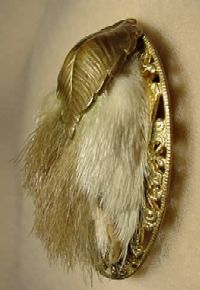 with monetary gain). By the time the Middle Ages dawned, rabbits' feet were also in wide use as lucky charms in Europe.
with monetary gain). By the time the Middle Ages dawned, rabbits' feet were also in wide use as lucky charms in Europe. 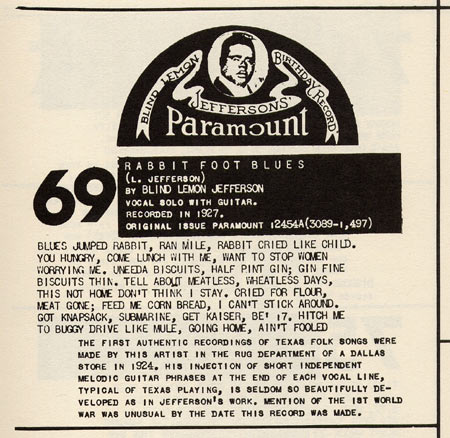 All the earlier traditions dropped into the American melting pot, but rabbit's feet weren't prominent culturally until the early 20th century, when the rise of blues music popularized "hoodoo," a collection of African-derived folk
All the earlier traditions dropped into the American melting pot, but rabbit's feet weren't prominent culturally until the early 20th century, when the rise of blues music popularized "hoodoo," a collection of African-derived folk 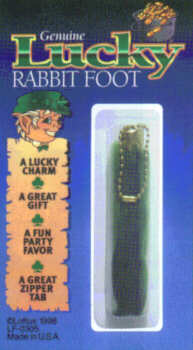
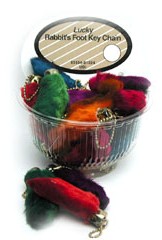 Millions of rabbit's feet were being generated by the farms every year. They had no practical commodity value, but they were easily preserved. As a result, rabbit's foot keychains were incredibly inexpensive to produce. They could be sold at a very low price and still be profitable.
Millions of rabbit's feet were being generated by the farms every year. They had no practical commodity value, but they were easily preserved. As a result, rabbit's foot keychains were incredibly inexpensive to produce. They could be sold at a very low price and still be profitable. 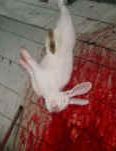 Interest in real fur bottomed around around 1980, and synthetic fur products were on the rise. Targeted by animal rights activists, the novelty toy manufacturers figured -- correctly -- that most kids weren't likely to notice the old switcheroo. Simulated rabbit's feet debuted, made with hard latex bones and deep pile synthetic fur (similar to a deep-pile rug).
Interest in real fur bottomed around around 1980, and synthetic fur products were on the rise. Targeted by animal rights activists, the novelty toy manufacturers figured -- correctly -- that most kids weren't likely to notice the old switcheroo. Simulated rabbit's feet debuted, made with hard latex bones and deep pile synthetic fur (similar to a deep-pile rug).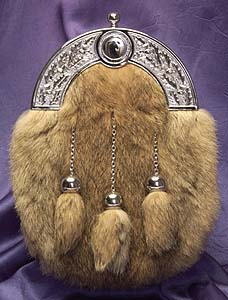 Today, the vast majority of lucky rabbits' feet on the market are fake. Granted, there's no scientific proof to show that a real rabbit's foot is lucky. But whatever benefit you were getting from a real rabbit's foot, you sure as hell aren't getting it from a fake one.
Today, the vast majority of lucky rabbits' feet on the market are fake. Granted, there's no scientific proof to show that a real rabbit's foot is lucky. But whatever benefit you were getting from a real rabbit's foot, you sure as hell aren't getting it from a fake one. 